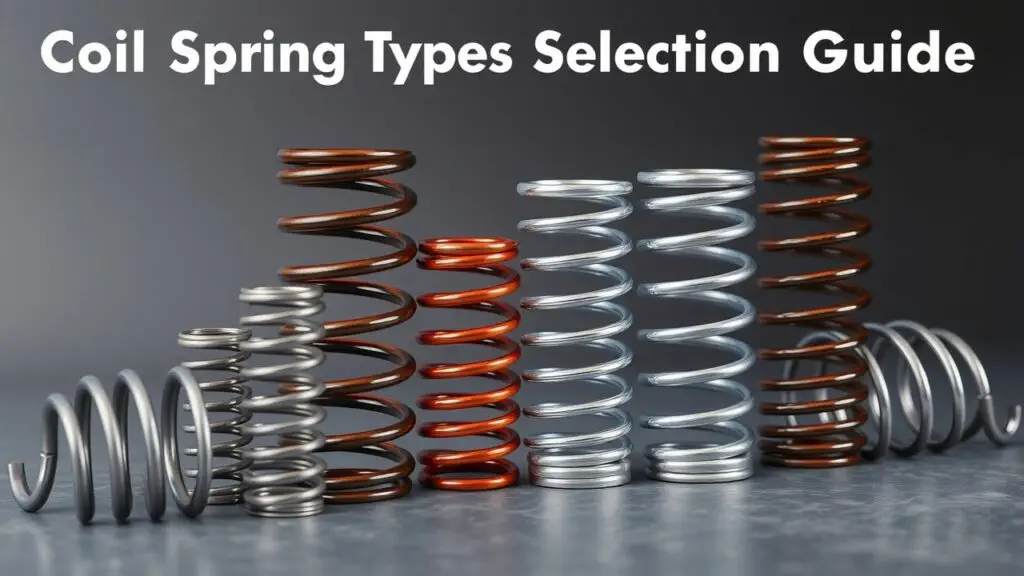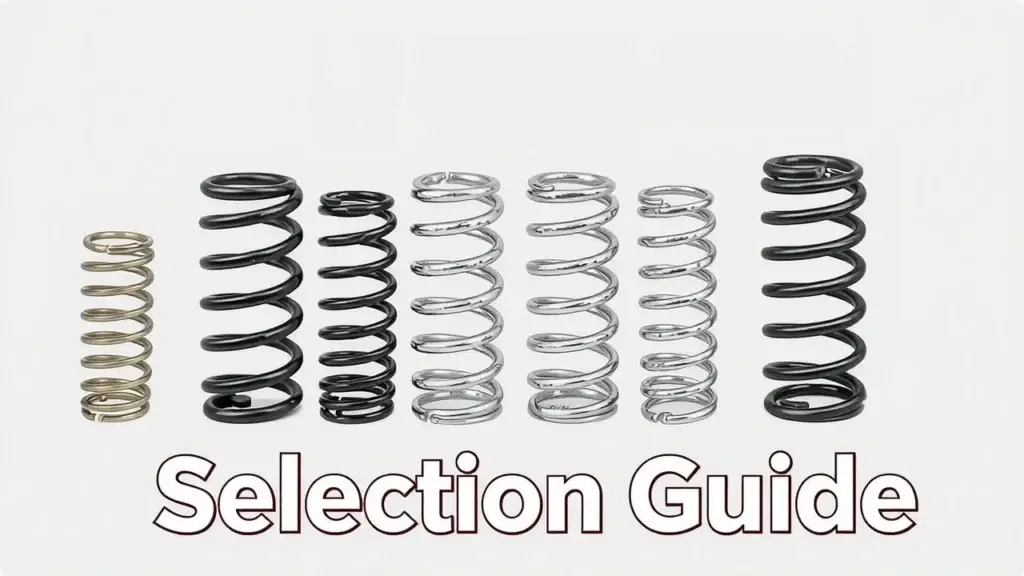Types of coil springs come in compression, extension, and torsion types, each suited for different applications. This guide helps you choose the right spring based on your needs.
What Are Coil Springs?

Coil springs are special elastic devices that store and release energy. They have a helical shape, which lets them either compress or stretch when pushed or pulled. This ability makes coil springs great at absorbing shock and keeping things steady in many situations.
The main job of coil springs is to hold energy when they change shape. When a force is applied, the spring either squishes or stretches, storing potential energy. This energy can then be let go when the load is removed. Because of this, coil springs are found in many places, like cars (for suspension), airplanes (in landing gear), and medical devices (like prosthetics).
Different types of coil springs exist based on what they do and how they’re used. Knowing these differences helps engineers choose the right spring for each situation.
Importance of Choosing the Right Type of Coil Spring
Choosing the right coil spring matters a lot for performance and safety in different uses. The right spring helps machines work better and last longer. For instance, using a compression spring when an extension spring is needed can cause equipment to fail or not work as well.
Using the wrong type can also make things unsafe, especially in important areas like car suspensions or industrial machines where everything needs to be precise. A good choice in coil springs not only extends their life but also boosts overall reliability.
Types Covered in This Guide
This guide will look at some key types of coil springs:
- Compression Springs: These springs push back when compressed. They get shorter under pressure.
- Extension Springs: These springs stretch when pulled apart. They are made to absorb tension.
- Torsion Springs: These springs twist around an axis and provide torque.
- Specialized Types: These include conical springs that taper down and volute springs that spiral, mainly used for heavy loads.
Knowing about these types helps people choose the right one for their specific needs while ensuring everything works smoothly across different applications.
Compression Springs
Compression springs are a key type of coil spring. They resist compressive forces and are found in many places, like industrial machines and consumer products. These helical coils can store energy when compressed and release it when they go back to their original shape.
How Do Compression Springs Work?
Compression springs work by absorbing compressive forces. When you push on the spring, it gets shorter, storing energy inside its coils. This energy is released when the load is taken off, allowing the spring to return to its free length. They play an important role in handling axial load forces in many mechanical systems.
Key Characteristics and Design Parameters
Here are some important design factors that affect how compression springs perform:
- Wire Diameter: The thickness of the wire affects both strength and flexibility.
- Solid Height: This is how tall a fully compressed spring is; it shows how much room a spring takes up when not loaded.
- Free Length: The length of the spring with no force applied; it helps figure out how much compression can happen.
- Pitch: This refers to the distance between coils; changing the pitch can change how stiff the spring is under loads.
- Number of Coils: More coils generally make a spring more flexible but can lower its strength.
Understanding these features helps engineers pick or create the right compression springs for their needs.
Applications
Compression springs are used in many industries because they’re so useful:
- Automotive Suspensions: They help absorb shocks from bumpy roads, making rides smoother.
- Shock Absorption Systems: Found in things like mattresses or office chairs for added comfort.
- Consumer Products: Used in everyday items like pens and toys, where controlled movement is needed.
Variations
There are some variations of compression springs that meet specific needs:
- Concave Springs: These have inward-curving ends for better stability during use.
- Convex Springs: These feature outward-curving ends, giving them different loading traits compared to regular designs.
Knowing about these variations helps users make smart choices for their specific needs.
Extension Springs Overview
Extension springs, also called tension springs, are mechanical springs that store energy. They stretch under load and help resist pulling forces. These springs are vital in many products because of how they function.
What Are Extension Springs Used For?
Extension springs are found in many places where a stretching force is needed. Here are some common uses:
- Garage Doors: They help open and close garage doors smoothly.
- Retractable Mechanisms: You see them in items like tape measures and dog leashes that retract when released.
- Industrial Applications: Many machines use extension springs to control movement under tension.
These handy components appear in everyday objects and complex machinery, showing their importance.
Extension Spring Hook & Loop Designs
The way an extension spring attaches can impact its effectiveness. Different hook and loop designs include:
Full loops
Full loops provide secure attachment points at both ends of the spring. This design helps spread stress evenly across the spring.
Side loops
Side loops give you more options for mounting but may not distribute stress evenly. They work well in tight spaces or specific alignments.
Double loops
Double loops add durability by having more material at each end. This can improve performance when handling heavy loads or frequent use.
Extension Spring Hook types
- Machine hooks: These attach directly to machinery parts, ensuring a strong connection with minimal risk of detachment.
- Crossover hooks: With an offset design, these hooks help keep parts aligned while allowing some movement.
- Extended hooks: Longer than standard machine hooks, they reach hard-to-access areas without losing strength.
Choosing the right hook type can make a difference in performance and reliability based on how they connect within a system.
Material Selection for Durability Under Tension Forces
Picking the right materials for extension springs is key for durability under tension forces. Common materials include:
- Music Wire Stainless Steel: Known for its strength and ability to handle repeated cycles without breaking.
- Chrome Silicon Alloys: These alloys offer high resilience against deformation in tough applications.
Using the right materials helps avoid fatigue failures, which happen when a spring wears out from constant loading. Proper material choice improves overall lifespan during heavy use.
How Torsion Springs Work?
Torsion springs are a type of mechanical spring. They work by twisting to store energy. When twisted, they release energy to return to their original shape. This twisting action makes torsion springs useful in many applications, especially where rotational movement is needed. For example, you’ll find them in automotive components and industrial machinery.
When a torsion spring experiences a twisting force, it produces torque. The amount of twist a spring can take before it fails depends on its design and materials. As it twists, it stores potential energy. When released, this energy changes into kinetic energy. This feature makes torsion springs ideal for situations that require controlled motion or resistance against rotation.
Key Design Features
The design of torsion springs includes some important features that affect how well they work:
Winding Direction
Torsion springs can be wound in two ways: right-hand or left-hand winding. Right-hand winding coils go clockwise, while left-hand winding goes counterclockwise. Choosing the right winding direction is key since it impacts how the spring will behave under load.
End Configurations
The end configurations also matter for how torsion springs function. Common designs include straight leg designs and angled leg configurations:
- Straight Leg Design: Both ends of the spring extend straight out from the coil body.
- Angled Leg Configuration: At least one leg bends away from the coil at an angle, which helps with attachment depending on installation needs.
These different designs help engineers pick the best option based on space limits or mounting requirements in various devices.
Applications
Torsion springs are used in many industries because they manage twisting forces well:
Common Uses in Various Industries
- Automotive Components: These springs often assist with door hinges, helping them open and close smoothly.
- Aerospace Components: They provide necessary tension for control surfaces like flaps or rudders.
- Industrial Machinery: Clamping devices often use torsion springs to maintain pressure without constant manual effort.
Examples of Specific Applications
- Garage doors depend on large torsion springs for lifting mechanisms.
- Clocks use small torsional elements to keep time accurately.
- Toys may have mini versions of these springs for moving parts.
- Medical devices often need these coils for precise movements during procedures.
Understanding how different industries utilize various types of coil springs aids designers in selecting solutions tailored to specific project demands while ensuring effective performance across many fields.
Specialized Coil Spring Types
Constant Force Springs
Constant force springs are special mechanical springs. They give a steady push or pull all the time, no matter how far they stretch or compress. This makes them perfect for things where you need the same tension consistently.
You can find constant force springs in many devices. For example, they work great in window shades and retractable tools. These springs store energy well, which helps them perform reliably over time.
When making constant force springs, choosing the right materials is key. Common choices include stainless steel and carbon steel. These materials are strong and last long. Understanding these factors can help engineers pick the best spring for their needs.
Volute Springs
Volute springs are another unique type of coil spring. They have a spiral shape that sets them apart from regular coil springs. This design allows them to flex a lot without needing much space, making them useful in tight spots.
One big perk of volute springs is their strength under load. They can handle heavy weights while staying stable when pushed or pulled. Industries like automotive and machinery use these springs when space is limited but high performance is a must.
Designing volute springs involves looking at load limits and how they flex. It’s important to think about where they’ll be used to get the best performance.
Other Specialized Springs
Beyond constant force and volute types, there are various other specialized coil designs:
- Conical Springs: These are shaped like a cone, allowing stiffness to change along their length.
- Hourglass Springs: Their hourglass shape helps them bend easily while reducing side movement.
- Power Springs: Used in quick-retract devices like tape measures, these springs store energy by coiling up.
Overview of Custom Springs
Custom-made coils are important when standard options won’t do. Different industries like aerospace and healthcare often need specially made springs to boost efficiency and reliability.
Spring Applications Across Industries
Specialized coil designs have various uses across many sectors:
- Automotive: They support suspension systems.
- Electronics: Springs help in switches.
- Healthcare: Used in medical devices for accurate functions.
Innovations in Spring Design
Recently, new methods have improved spring design and manufacturing. These advancements help increase performance and durability while making production faster—keeping modern mechanical parts strong yet flexible in today’s changing markets.
Understanding these specialized types allows engineers to choose the right option for specific tasks in mechanical systems today!
Key Design Parameters

When designing coil springs, some key factors really matter. These include wire diameter, number of coils, pitch, and spring index.
Wire Diameter: The wire diameter is super important. It affects how strong or flexible a coil spring can be. Thicker wires can carry heavier loads but may not compress or extend as easily. Thinner wires let springs move better but can struggle with heavy weights. You need to choose the right wire diameter based on what the spring will do.
Number of Coils: The total number of coils in a spring changes how it works. More coils usually mean more flexibility and less stiffness, but this can also lower how much weight it can hold. Fewer coils make the spring stiffer and better at carrying heavy loads but might limit movement. Knowing how these elements work together helps create springs that fit your needs.
Pitch: Pitch is about the space between coils when they aren’t under load. This spacing affects how tightly or loosely the coils are arranged during use. If you have a larger pitch, there’s more space between coils, which can help with flexibility but might reduce stability when under heavy loads. Tighter pitches give better control but may put more stress on individual coils.
Spring Index: The spring index is a ratio of coil diameter to wire diameter (D/d). It’s a key design factor because it impacts manufacturing methods and performance. A low spring index means tightly wound springs that are stronger but harder to make without issues like bending or distortion. A higher index makes production easier while still providing decent performance for what you need.
Stress Calculations and Fatigue Life
Understanding stress calculations helps ensure coil springs work well over time.
- To find stress in coil springs from loads, you often use formulas based on Hooke’s Law (F = kx). In this formula, F is the force applied at one end of the spring, x is the movement caused by that force, and k is the stiffness constant affected by material properties and dimensions like length or radius.
- Factors that affect fatigue life include material properties like tensile strength—how much pulling force a material can handle before breaking—and fatigue strength—the maximum cyclic stress below which failure won’t happen after many loading cycles under different conditions (like temperature changes). Operating conditions also matter; extreme temperatures can wear down materials quicker than expected if not considered in designs.
Manufacturing Processes
The way coil springs are made is crucial for their quality:
- Cold Forming vs Hot Forming: Cold forming shapes metal at room temperature without heat. This often leads to better surface finishes and accuracy compared to hot forming, where metals are heated until soft enough to shape easily; however, this may cause issues with precision due to thermal expansion as it cools down.
- Other important processes might involve heat treatment techniques aimed at boosting hardness through controlled cooling after shaping to improve durability for different operating conditions later on once installed in machines needing reliable performance over time.
Surface Treatments
Surface treatments make coil springs last longer by protecting them from damage:
- There are various treatments like passivation—a chemical process that enhances corrosion resistance by creating protective oxide layers on stainless steel parts—or coating methods like powder coating or galvanizing that add barriers against moisture and other elements that might cause wear.
- When picking specific treatments, consider what the application needs—for example, if a spring will be near saltwater, you’ll want coatings designed to resist corrosion; in other cases where looks matter more than durability, aesthetics might take priority instead!
Selecting the Right Coil Spring
Factors Affecting Spring Selection
Choosing the right coil spring is not just about picking one off the shelf. You need to think about several things that will affect how well it works for your needs. The main types of coil springs are compression springs, extension springs, and torsion springs. Each type has its own uses and features.
Load Requirements: First, you need to know how much weight or force the spring must handle. Compression springs shorten when you push down on them. Extension springs stretch when you pull on them, and torsion springs twist to create force.
Material Properties: The material of the spring matters a lot. It impacts strength, durability, and flexibility. Common choices include steel alloys and stainless steel. Sometimes, plastic or composite materials might be used depending on where the spring will be used.
Operating Environment: Think about where the spring will work. Is it going to be in a hot place? Will it get wet or touch chemicals? These factors can change what material you should use. For example, if it’s going to be exposed to water or chemicals, stainless steel is a smart choice because it doesn’t rust easily.
Cost: Money often plays a role in which spring you choose. Custom-made springs can fit specific needs but usually cost more than standard ones.
Lifespan: How long do you need the spring to last? Springs that go through many cycles might need extra checking to avoid breaking down early.
Step-by-Step Spring Selection Guide
Finding the right coil spring involves a few simple steps:
- Identify Application Needs: Start by figuring out what kind of movement is needed, like pushing or pulling.
- Determine Load Specifications: Check both constant loads and loads that change while the spring is working.
- Select Material Based on Conditions: Pick materials that match your needs, like being resistant to rust or high heat.
- Choose Spring Type Accordingly:
- Use compression springs if you need to absorb force.
- Pick extension springs for pulling forces.
- Go for torsion springs if you’re dealing with twisting movements.
- Consider Custom Manufacturing Options if Needed: If you can’t find a standard size that works, look into custom manufacturing services from suppliers.
- Review Engineering Mechanics Principles Related To Springs: Learn basic concepts like Hooke’s Law which says a spring’s force is directly related to how much it is stretched or compressed within limits.
Troubleshooting Common Spring Issues
Knowing about common problems with coil springs helps keep them reliable:
- Spring Failure Modes: Springs can fail in two main ways—by stretching too far until they lose their shape or by getting cracks over time from repeated use.
- Fatigue Analysis Importance: Checking for fatigue helps make sure your design can handle stress without breaking too soon.
- Assessing Performance Regularly: Keep an eye on how the spring performs by checking its deflection rates regularly; any big changes could mean wear and tear.
- Ensuring Reliability Through Maintenance Practices: Regular inspections can catch issues early, like wear patterns that mean it’s time for a replacement before something goes wrong.
By following these steps and tips, you’ll have a better chance of selecting the perfect coil spring for your needs!
Frequently Asked Questions (FAQs)
What are the different types of springs?
Springs can be classified into several types. The main categories include compression springs, extension springs, and torsion springs. Each type serves a specific function based on its design.
How do I choose the right coil spring?
Select a coil spring by assessing the application needs. Determine load requirements, consider material properties, and evaluate the operating environment. Understanding these factors helps ensure optimal performance.
What materials are commonly used in coil springs?
Coil springs are often made from materials like stainless steel and music wire. These materials offer high strength and durability under varying loads and conditions.
What is spring fatigue?
Spring fatigue refers to the weakening of a spring after repeated cycles of loading and unloading. This phenomenon can lead to breakage if not monitored carefully.
How do I calculate spring rate?
The spring rate is calculated using Hooke’s Law, where the force applied is divided by the deflection produced. This provides insight into the stiffness of the spring for specific applications.
What is the purpose of surface treatments on springs?
Surface treatments enhance corrosion resistance and improve durability. Common methods include powder coating and galvanizing, which protect springs from environmental damage.
What are specialized types of coil springs?
Specialized types include constant force springs, volute springs, and conical springs. Each type is designed for unique applications where standard coil springs may not suffice.
Understanding Various Types of Springs
- Compression Springs: Resist compressive forces; used in automotive suspension systems.
- Extension Springs: Store energy when stretched; found in retractable mechanisms like tape measures.
- Torsion Springs: Generate torque; used in door hinges and many rotating mechanisms.
- Constant Force Springs: Provide consistent force; common in window shades.
- Conical Springs: Change stiffness along their length; ideal for limited space applications.
- Volute Springs: Flexible under load; suitable for heavy machinery.
- Helical Springs: Versatile; used in various industrial applications.
- Barrel Springs: Effective in shock absorption; common in construction equipment.
Understanding these variations helps engineers select suitable springs for their needs across industries such as automotive, aerospace, and medical devices.
Related Topics
- types of spring hooks
- types of spring materials
- types of spring surface treatments
- types of spring manufacturing processes
- types of spring applications
- types of spring failure modes
- types of specialized coil springs



Types of Coil Springs: A Selection Guide